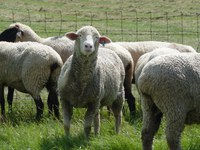Adding to the Sheep Flock Requires Planning
(Click the image below to view a high-resolution image that can be downloaded)
The sheep industry’s current market trends are prompting sheep producers to consider expanding their flocks.
“The market trends are encouraging for the U.S. sheep industry for two reasons: Lamb and wool markets are strong, and the cost of livestock feed is down considerably,” says North Dakota State University Extension Service sheep specialist Reid Redden. “With these market conditions, those in the sheep business are considering purchasing breeding ewes or retaining more replacement ewe lambs.”
However, those wanting to add to an existing flock or start a sheep enterprise have many factors to consider, he cautions.
One of those factors is whether the operation has the space, facilities, resources, know-how and labor force required to manage these additional ewes successfully. Once the livestock manager has decided on how many females can be added to the operation, the next step is to determine what type of sheep and how much the operation can afford to pay for these animals.
Redden says producers need to calculate the yearly depreciated value of breeding animals. They can do that by subtracting the salvage value of cull ewes from the purchase price and dividing by the years of production. For instance, yearling commercial ewes are valued at $225 and cull ewes are valued at $75. Commercial ewes average about five years of production; therefore, $225 minus $75 divided by 5 equals $30 per year in depreciation value.
The most common practice for adding to the flock is retaining ewe lambs. The current value of high-quality ewe lambs is about $200. Their depreciation value is slightly less than yearling ewes; however, ewe lambs typically are less productive than mature ewes when they lamb at the age of 1. Often their first year of production is at the break-even point.
In the western part of the U.S., ewes are culled at 5 or 6 years of age due to the challenging environment they are managed in, regardless of body condition. However, in the Midwest, the feed resources are higher quality and more feed is available, which allows for these ewes to remain in production for a couple of extra years. The common practice for western ewes that are in good body condition is for them to be sold as “short-term” ewes. They typically are worth $20 more than cull ewes. If these ewes remain in production for two additional years, their depreciation value is $10 per year.
The next step in determining what type of replacement females to add to the flock requires managers to estimate the earning potential of the ewes in question. According to the Center for Farm Financial Management, the five-year average for direct expenses per breeding ewe are $143 and the value of feeder lambs is $156. For ewes producing one lamb, the earning potential is a meager $13 ($156 minus $143). However, ewes have the ability to rear two lambs, which drastically increases the flock’s earning potential. Conservatively, ewes rearing twins have an earning potential of about $150 per year.
According to the U.S. Department of Agriculture’s National Agricultural Statistics Service, the average lamb crop in the U.S. is 110 percent (1.1 lambs per breeding ewe), whereas, the average lamb crop in the upper Midwest is much higher (145 percent).
Prolificacy is a combination of genetics and management. Shepherds looking at adding sheep to their flock should place strong consideration on the prolificacy of the breed of sheep and genetic background. In general, most all flocks should set a goal to market at least a 135 percent lamb crop.
“The final and extremely important aspect when considering adding ewes to an operation is flock biosecurity,” Redden says. “The U.S. sheep industry has many different commonly occurring diseases that negatively affect productivity, such as aborting agents, footrot, ovine progressive pneumonia and parasites. The best way to prevent most of these issues is to not introduce them to the flock from the purchase of outside animals.”
Females tend to spread diseases between flocks more often than males. Redden recommends that, in general, if producers purchase outside ewes, they should create a quarantine area for the new flock for at least 30 days. Also, each disease is different, so shepherds should consult a veterinarian to establish a health management plan.
NDSU Agriculture Communication - Oct. 31, 2014
| Source: | Reid Redden, (701) 231-5597, reid.redden@ndsu.edu |
|---|---|
| Editor: | Ellen Crawford, (701) 231-5391, ellen.crawford@ndsu.edu |


